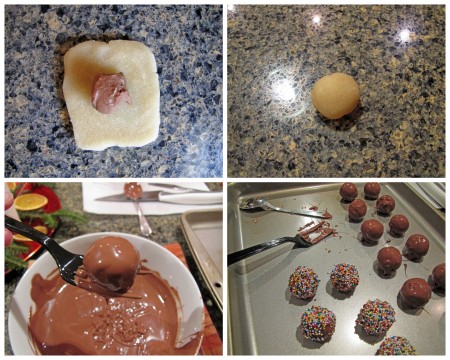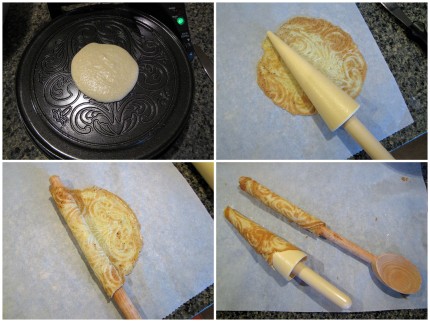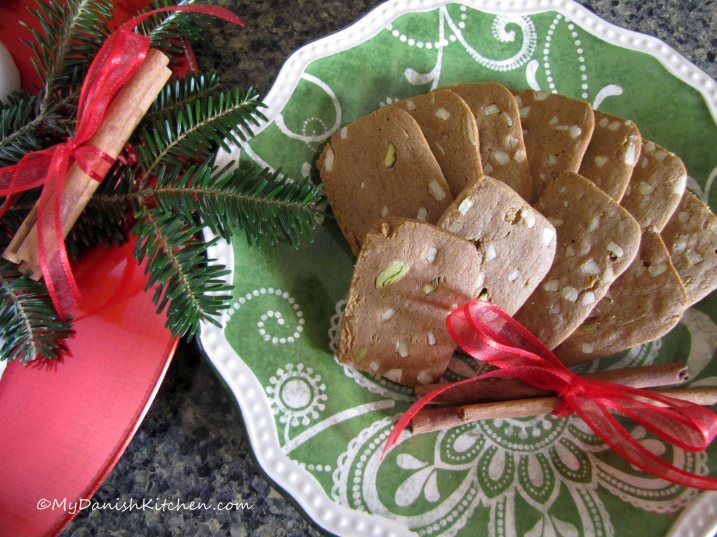
Honninghjerte
Honninghjerter has a special place in my heart. I remember as a child always starring at the hearts in the store and it was a special occation when I was allowed to get one. The hearts are sold only at Christmas time and they are decorated with a glansbillede which were very popular in Denmark when I was growing up. All the girls in my class would collect glansbilleder and we would trade them with each other, so making these Honey Hearts brought back a lot of wonderful memories.

Making Pre-dough, melt honey and mix with flour, store dough for 1 month.
To break up Pre-dough, carefully chip dough into small pieces using the tip of your knife.
Honninghjerter is typically not a Christmas cookie or cake that you bake at home for Christmas, perhaps because it is a rather lengthy process to make them. It is only in the past few years that they have become popular to make and I have seen them on different Danish food blogs. What I found was a lack of description and direction on the details on how to make them. For example, what is the best way to break up the very hard Pre-dough and there were no descriptions anywhere of how big the hearts should be, when cut out. So this has really been a trail and error ordeal, but the hearts turned out wonderful and they tasted just like I remember them, like Christmas 😀

Mixing dough can be a rough ride, chop Pre-dough into small pieces to make mixing easier. Image #2 is dough after 3 minutes of mixing, image #3 is dough after 6 minutes of mixing. Dough will be very sticky.
Making Honninghjerter is a very long process. If you want them ready for Christmas, you should make the Pre-dough around mid November. The Pre-dough should rest for 1 month but you can probably get away with less, if you get a late start. The Pre-dough will get very hard after a month of resting, and this is normal. I found the best way to break up the hard dough is by carefully inserting the tip of a sharp knife and twist the knife to break loose the dough. The smaller the pieces, the easier it will be to mix everything up later, so feel free to give the dough a quick chop after it’s broken up.

Using a cookie cutter will save you time. My pre-baked hearts were 11 cm wide (4.3 inches) which were a little too big. Note: dough will spread out quite a bit during baking. When rolling the dough it will be very sticky, use plenty of flour for rolling.
As for the size of the hearts I didn’t know what size cookie cutter to buy, so I simply just cut a template out of paper and cut them out with a knife (which turned out to be very time consuming). My pre-baked hearts measured 11 cm wide (4.3 inch) but grew quite a bit during baking to 15 cm wide (5.9 inch). The hearts are suppose to be big but I thinks mine turned out jumbo 🙂 so I would recommend scaling them down a bit.

After baking, the heart will be a little hard. They now need to rest with a moist towel in the refrigerator for 3-4 days. This is how I did it without the towel resting directly on the hearts.
Honninghjerter – Honey Hearts (makes 13 large)
Ingredients:
Pre-dough: (made 1 month ahead)
500 gram honey
500 gram all-purpose flour
Directions for Pre-dough:
Pour honey in a small cooking pot and heat to 40-50 degrees Celsius (104-122 degrees Fahrenheit). Combine warm honey and flour until a smooth mass, place into a container and seal with lid. Store container in a cool, dry place for a minimum of 1 month. The honey pre-dough will get very hard, which is alright. It will soften up again later in the recipe.
Honninghjerter dough:
2 egg yolks
10 gram hjortetaksalt
10 gram potaske
1 tablespoon water
Pre-dough, chopped into small pieces
5 gram ground cinnamon (approx 1 small tablespoon)
5 gram ground ginger (approx 1 small tablespoon)
5 gram ground cloves (approx 1 small tablespoon)
200 gram dark chocolate (for decorating)
Directions for Honninghjerter:
The Pre-dough will now be very hard. Take a sharp knife and carefully start chipping away at the hard dough. Put tip of knife into dough and give a twist to break up the dough little by little. Smaller pieces of honey dough will make your work easier later on, so if you have big chunks, chop them smaller.
Mix egg yolks with hjortetaksalt, set aside. Stir potaske into water until completely dissolved, set aside. Place pre-dough pieces into the bowl of a stand-mixer (the mixing can also be done by hand but will require a lot of muscle). Add egg mixture and potaske mixture to dough. Add cinnamon, ginger and ground cloves. Start mixer on low for 3 minutes, it will be a rough ride. Increase speed to high and mix for another 3 minutes, dough will now become smooth and very sticky.
Preheat oven to 180 degrees Celsius (350 degrees Fahrenheit). Line baking sheets with parchment paper and sprinkle paper lightly with flour, set aside.
Sprinkle a very generous layer of flour onto your work surface and scrap dough out onto floured surface (using a wooden spoon works really well for scraping out the sticky dough). Sprinkle more flour on top of dough and give a quick knead. Roll dough out to 4 mm thickness (0.15 inch), sprinkle more flour as needed. Press or cut out heart shapes, using a spatula, place hearts onto baking sheets leaving 5 cm (2 inches) distance between hearts. Repeat rolling of scrap dough and cutting out hearts until dough is used up. Bake hearts for 8-10 minutes. Test for doneness by gently pressing a finger into center of heart, when done it should spring back and not leave a finger imprint.
Storing hearts: Allow hearts to cool completely. Using a pastry brush, remove excess flour from bottom of each heart. At this point the hearts will be quite hard and they now need to soften up for a couple of days in the refrigerator. Place hearts in a container with a moist clean towel. I did this by lining a box with plastic, place hearts inside box, then one of my cooling racks and then the moist towel. The rack just prevents the moist towel from resting directly on the hearts. Seal container and store in refrigerator for 3-4 days. After the four days, continue to store hearts in refrigerator in a regular contain, but without the moist towel. Hearts can last for over a month in refrigerator. Note: remove only the hearts that you need, brush with melted chocolate and enjoy the same day. Glædelig Jul and Merry Christmas.

Honninghjerte
Source: Claus Meyer

Read Full Post »


































